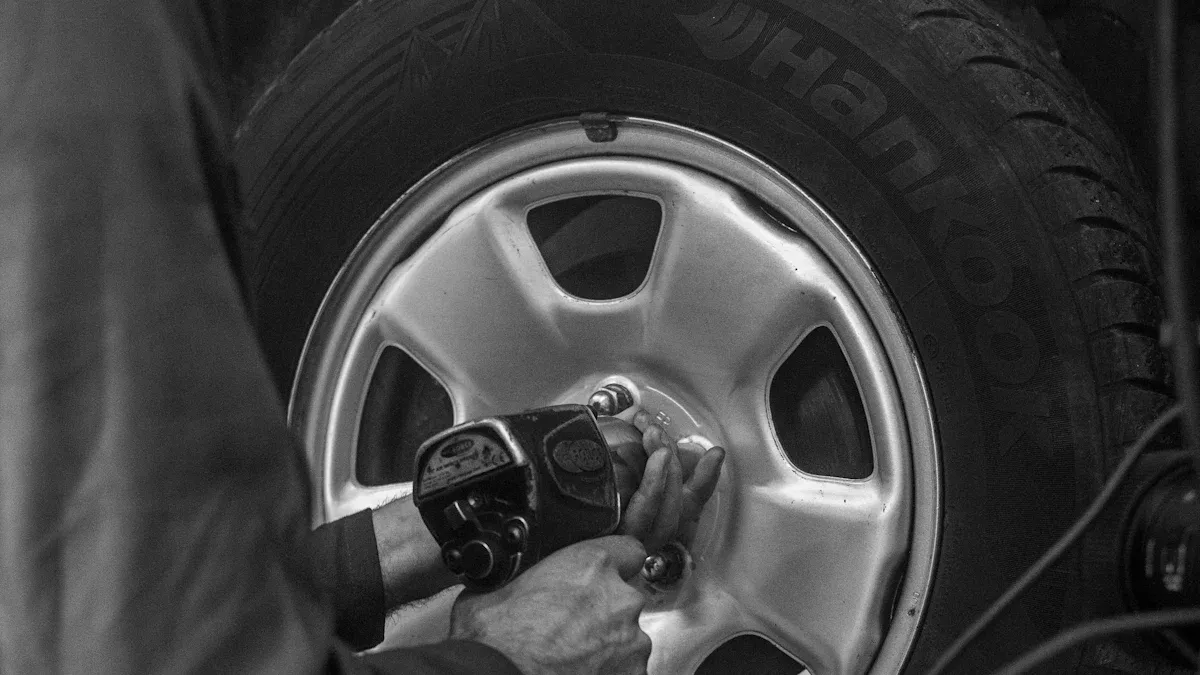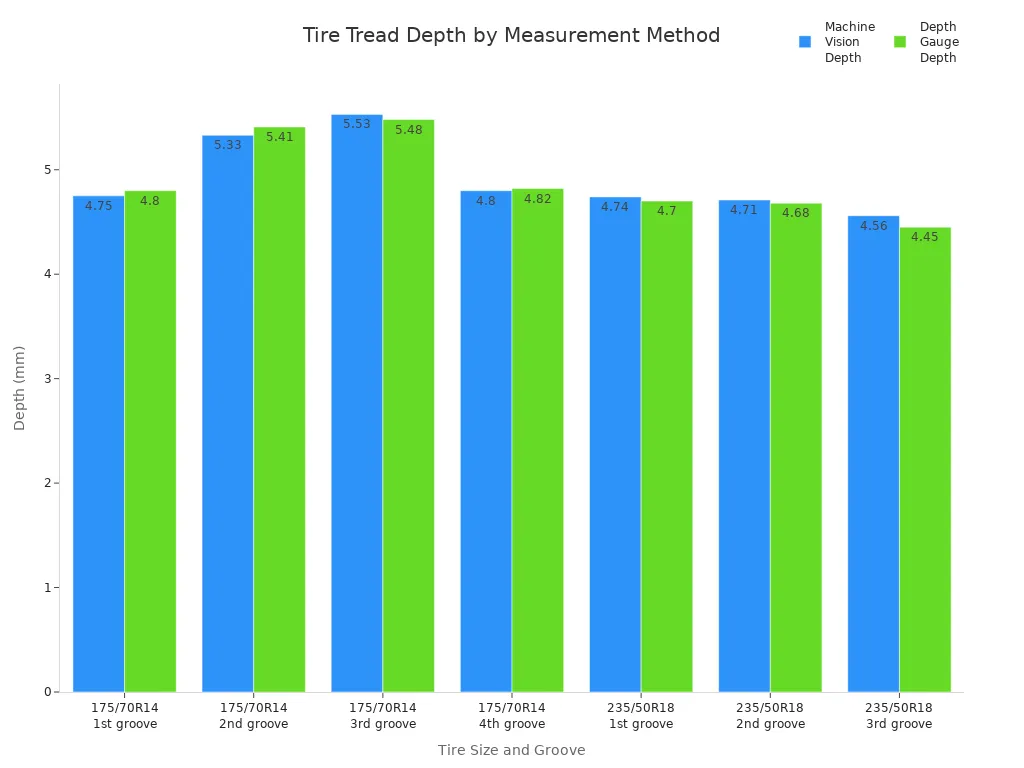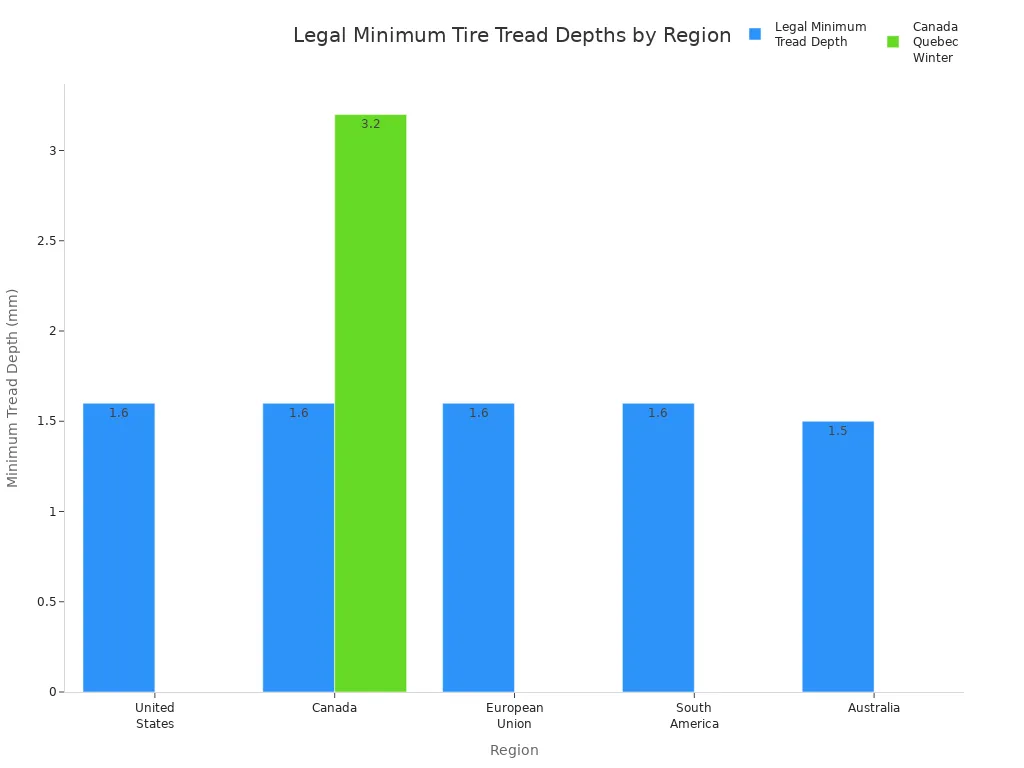Measuring tire tread depth accurately is crucial for your safety on the road. Did you know that tires with tread depth less than 1.6 mm have a threefold higher chance of being involved in tire-related crashes? Keeping your tires in good shape can significantly reduce these risks. Regularly checking your tread depth helps maintain vehicle performance, too. With various methods available, including how to use tire tread depth gauge, you can easily ensure your tires are up to standard.
Najważniejsze informacje
Measuring tire tread depth regularly keeps you safe by reducing risks like hydroplaning and longer stopping distances.
The legal minimum tread depth in the U.S. is 2/32 inch; replace tires once they reach this limit to avoid fines and accidents.
Używaj miernika głębokości bieżnika opony for the most accurate measurements and check multiple spots on each tire for even wear.
Perform monthly tire inspections and maintain proper tire pressure to extend tire life and improve vehicle performance.
Simple tests like the penny test help spot worn tires quickly, but combining methods gives the best safety check.
Importance of Tread Depth
Implikacje bezpieczeństwa
When it comes to driving, your safety is paramount, and tire tread depth plays a crucial role in that. Worn tires can lead to serious safety risks. For instance, tires with tread depth as shallow as 4/32″ can increase stopping distances by a staggering 43% on wet roads at 60 mph. This means you could need an extra 87 feet to stop compared to new tires! 🚗💨
Here are some specific safety risks associated with low tread depth:
Aquaplaning: Low tread depth reduces your tires’ ability to channel water away, increasing the risk of sliding uncontrollably on wet roads.
Przegrzewanie się: Shallow grooves prevent cooling airflow, causing tires to overheat and potentially blow out.
Przebicia: Worn tires are more prone to dangerous blowouts, especially at high speeds.
Trudności z zatrzymaniem się: Reduced tread compromises braking effectiveness, increasing stopping distances.
Increased risk of punctures: Thinner tread makes tires more susceptible to sharp objects.
Loss of air pressure: Worn tires tend to lose air faster, impairing grip and vehicle control.
Compromised steering and vehicle control: Bald tires cannot maintain proper grip, making steering difficult and unsafe.
The National Highway Traffic Safety Administration (NHTSA) reports that one in every 11 crashes involves a tire-related issue. This statistic highlights the critical safety risk posed by worn tires, even before they reach the legal tread depth limit.
Legal Requirements
In the United States, the legal minimum tire tread depth for passenger vehicles is generally set at 2/32 inch (approximately 1.6 mm). This standard is enforced in most states, meaning you must replace your tires once the tread wears down to this depth.
To help you check your tread depth, you can use the ‘penny test.’ Simply place a penny upside-down in the tread grooves. If you can see all of Lincoln’s head, your tread is below the legal limit and needs replacing. Additionally, many tires have built-in wear bars that become visible when the tread reaches 2/32 inch, signaling the need for replacement.
Here’s a quick overview of the legal minimum tire tread depth requirements in major regions:
Region | Minimum Legal Tire Tread Depth | Notes on Regional Variations |
|---|---|---|
Polska | 2/32 inch (1.6 mm) | Varies slightly by state; ‘penny test’ commonly used |
Europa | 1.6 mm (2/32 inch) | Standard across EU countries |
Japan | 1.6 mm (2/32 inch) | Matches EU and US standard |
China | 2 mm (0.079 inch) | Slightly higher than US and EU minimum |
India | Approximately 1 mm (0.039 inch) | Lower than US and EU standards |
Failing to comply with these regulations can lead to fines or tickets during inspections or after accidents. Moreover, driving with tires below the legal tread depth can increase the likelihood of accidents by impairing braking, steering, and stability, especially in adverse weather conditions.
Regularly checking your tire tread depth is not just a good practice; it’s a legal requirement that helps keep you and others safe on the road.
Measurement Techniques

Jeśli chodzi o measuring tire tread depth, you have several reliable techniques at your disposal. Each method has its strengths, so let’s dive into how to use them effectively.
How to Use Tire Tread Depth Gauge
Using a tire tread depth gauge is one of the most accurate ways to measure tread depth. Here’s how to do it:
Zero the Gauge: Start by pressing the gauge against a flat surface. Fully insert the measuring pin into the barrel to calibrate it to zero.
Insert the Pin: Place the measuring pin into the center of the main tread groove. Push down until the base contacts the tread on both sides.
Odczytaj pomiar: Carefully remove the gauge by holding the barrel without touching the pin. Read the tread depth displayed.
Repeat for Accuracy: It’s best to take multiple measurements—at least two more spaced about 15 inches apart. This helps you get an average reading, which is more reliable.
Experts recommend this method because it provides precise measurements, typically accurate to ±1% plus 0.0012 inch (0.03 mm). This level of accuracy is crucial for assessing tire safety and wear.
Visual Checks
While visual checks can’t replace precise measurements, they’re a good first step in tire maintenance. Here’s what to look for:
Uneven Wear Patterns: Check for signs of uneven tread wear, which can indicate issues like misalignment or under-inflation.
Treadwear Indicator Bars: Most tires have built-in wear bars that become flush with the tread surface when it reaches 2/32 inch. If you see these bars, it’s time to replace your tires.
Uszkodzenia fizyczne: Look for cracks, cuts, or bulges in the sidewalls. These can signal serious problems that need immediate attention.
Keep in mind that while visual inspections can identify some issues, they often miss critical safety concerns. A national survey found that nearly 60% of tire inspections rely solely on visual checks, which identify safety-related issues less than 40% of the time. So, while visual checks are helpful, they should be complemented with more precise methods.
Test Penny
The penny test is a quick and easy way to gauge your tire tread depth. Here’s how to do it:
Insert a Penny: Take a penny and place it upside down in the tread groove, with Lincoln’s head facing down.
Sprawdź widoczność: If you can see the top of Lincoln’s head, your tread depth is below 2/32 inch, indicating that it’s time for new tires.
While the penny test is a convenient method, it’s not as precise as using a tire tread depth gauge. It serves as a rough estimate rather than a definitive measurement. For a more thorough assessment, consider combining this test with professional evaluations or using a tread depth gauge.
Automotive experts recommend using multiple methods to ensure you get an accurate picture of your tire health. By checking at various points on the tire, you can assess even wear and catch potential issues early.

Tips for Accurate Measurement
Getting accurate measurements of your tire tread depth is essential for safety and performance. Here are some best practices to follow:
Best Practices
Use the Right Tools: Always use a tread depth gauge that measures in 32nds of an inch or millimeters. This ensures you get precise readings.
Measure at Multiple Locations: Tires wear unevenly, so check tread depth at various points around the tire. This helps you spot any irregular wear patterns.
Regular Checks: Aim to measure your tire tread depth at least once a month. If you’re planning a long trip, do it before you hit the road. This way, you can catch any early signs of wear.
Record Your Measurements: Keep track of your measurements alongside your vehicle’s mileage. This practice helps you predict when it’s time for a tire replacement.
Avoid Coin Tests for Precision: While the penny and quarter tests can give you a rough idea, they’re not as accurate as using a gauge. Stick to professional tools for reliable results.
Common Mistakes
Even seasoned drivers can make mistakes when measuring tread depth. Here are some common pitfalls to avoid:
Inconsistent Measurements: Different gauges can yield varying results if not calibrated correctly. Always ensure your tools are in good working order.
Ignoring Multiple Points: Measuring only in one spot can lead to inaccurate assessments. Remember to check multiple locations on each tire.
Improper Gauge Use: Make sure to insert the gauge into the shallowest groove and press it flat against the tread surface. Failing to do this can lead to misleading readings.
Neglecting Regular Checks: Skipping monthly checks can put you at risk. Regular inspections help maintain tire performance and safety, especially in changing weather conditions.
By following these best practices and avoiding common mistakes, you can ensure that your tire tread depth measurements are accurate and reliable. This will help keep you safe on the road and prolong the life of your tires.

Maintenance Tips
Maintaining your tires is essential for safety and longevity. Regular inspections and proper inflation can significantly extend the life of your tires and improve your vehicle’s performance. Here’s how you can keep your tires in top shape.
Regularne inspekcje
You should inspect your tires regularly to catch any issues early. Monthly tire inspections can help you spot wear, cracks, or bulges before they become serious problems. Here are some key benefits of regular inspections:
Early Detection: You can identify signs of wear or damage, which helps prevent accidents.
Improved Handling: Well-maintained tires enhance your vehicle’s handling and traction.
Oszczędności kosztów: Catching issues early can save you money on repairs and replacements.
To help you stay on track, here’s a quick reference table for recommended inspection frequencies:
Rodzaj inspekcji | Recommended Frequency |
|---|---|
Tread wear inspection | Miesięcznie |
Sprawdzanie ciśnienia w oponach | Every 2 to 4 weeks |
Tire rotation | Every 5,000 to 7,000 miles |
Spare tire check | Monthly or during oil changes |
Odpowiednie Napompowanie
Proper tire inflation is crucial for even tread wear and maximizing tire life. When your tires are over-inflated, the tread wears more in the center. This leads to uneven wear and shortens the tire’s lifespan. On the other hand, under-inflation causes more wear on the edges.
To maintain optimal tire pressure, check it at least every 2 to 4 weeks. This simple step can improve fuel efficiency by up to 3.3% and prevent lifespan reduction by up to 25% due to under-inflation. Here are some tips for maintaining proper inflation:
Check Pressure Regularly: Use a reliable gauge to ensure your tires are inflated to the manufacturer’s recommended levels.
Adjust for Temperature Changes: Tire pressure can drop in colder weather, so check it more frequently during winter months.
Monitor for Uneven Wear: If you notice uneven tread wear, it might indicate improper inflation or alignment issues.
By following these maintenance tips, you can enhance your tire performance, improve safety, and extend the life of your tires. Regular inspections and proper inflation are simple yet effective ways to keep your vehicle running smoothly.
In summary, measuring tire tread depth is vital for your safety and vehicle performance. Regular checks help you avoid dangerous situations like hydroplaning and extended stopping distances. Experts recommend measuring tread depth at least monthly and replacing tires before they reach the legal minimum of 2/32 inches. Remember, maintaining proper tread depth not only ensures compliance with regulations but also enhances traction and stability on the road. By staying proactive with inspections and maintenance, you can significantly reduce the risk of tire-related accidents and keep yourself and others safe. 🚗✨
FAQ
What is the ideal tread depth for safety?
For optimal safety, maintain a tread depth of at least 4/32 inch (3.2 mm) for wet conditions. This depth helps prevent hydroplaning and ensures better traction.
Jak często powinienem sprawdzać głębokość bieżnika opony?
You should check your tire tread depth at least once a month. If you’re planning a long trip, do it before you hit the road to ensure safety.
Czy mogę użyć linijki do pomiaru głębokości bieżnika?
Yes, you can use a ruler, but a miernika głębokości bieżnika opony provides more accurate measurements. It’s worth investing in a gauge for precise readings.
What happens if my tires are below the legal limit?
If your tires fall below the legal limit of 2/32 inch (1.6 mm), you risk losing traction and increasing stopping distances. Replace them immediately for safety.
Jak mogę wydłużyć żywotność swoich opon?
To extend tire life, maintain proper inflation, rotate your tires regularly, and perform monthly inspections. These practices help ensure even wear and improve performance.
Zobacz także
Step-By-Step Guide To Measuring Tire Tread Depth Correctly
Understanding Smart Tire Tread Depth Sensors And Their Function
Znaczenie regularnych kontroli głębokości bieżnika opon dla bezpieczeństwa






